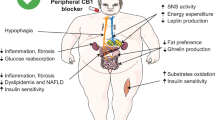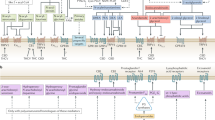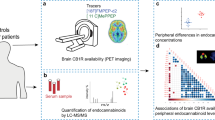Abstract
Presentations in this symposium addressed effects and modes of action of endocannabinoids in various tissues in relation to metabolic disorders. Endocannabinoids are produced and exert their effect in various brain sites, including the mesolimbic reward circuitry and the hypothalamus. Both of these regions have direct ties to energy metabolism regulation, particularly food intake and energy expenditure. These data clearly suggest that the observed beneficial effects of CB1 (cannabinoid receptor 1) receptor antagonists on obesity may be related to the central endocannabinoid system. On the other hand, data presented on cannabinoid action in the liver and white adipose tissues clearly indicate that CB1-mediated events in affecting metabolic phenotype may occur in peripheral tissues as well. This together with the reported results from human trials on CB1 antagonists showing that the initial anorectic effect of rimonabant is diminished after the first weeks while longer lasting weight loss is achieved do indicate that peripheral action of cannabinoids are very important in body weight regulation. Should this hold true in the long run, antagonizing CB1 receptors with compound not crossing the blood–brain barrier could revolutionize pharmaceutical approaches to obesity by offering a tool that short cuts the central nervous system.
This is a preview of subscription content, access via your institution
Access options
Subscribe to this journal
Receive 12 print issues and online access
$259.00 per year
only $21.58 per issue
Buy this article
- Purchase on Springer Link
- Instant access to full article PDF
Prices may be subject to local taxes which are calculated during checkout

Similar content being viewed by others
References
Brobeck JR . Mechanisms of the development of obesity in animals with hypothalamic lesions. Physiol Rev 1946; 26: 541–559.
Brobeck JR, Tepperman J, Long CNH . Experimental hypothalamic hyperphagia in the albino rat. Yale J Biol Med 1943; 15: 831–853.
Hetherington AW, Ranson SW . Hypothalamic lesions and adipocity in the rat. Anat Rec 1940; 78: 149.
Hetherington AW, Ranson SW . The relation of various hypothalamic lesions to adiposity in the rat. J Comp Neurol 1942; 76: 475–499.
Anand BK, Brobeck JR . Localization of a feeding center in the hypothalamus of the rat. Proc Soc Exp Biol Med 1951; 77: 323–324.
Coons EE, Cruce JAF . Lateral hypothalamus: food and current intensity in maintaining self-stimulation of hunger. Science 1968; 159: 1117–1119.
Valenstein ES, Cox VC, Kakolewski JW . Modification of motivated behavior elicited by electrical stimulation of the lateral hypothalamus. Science 1968; 159: 1119–1121.
Valenstein ES, Mittleman G . Ingestive behavior evoked by hypothalamic stimulation and schedule-induced polydipsia are related. Science 1984; 224: 415–417.
Elmquist JK, Elias CF, Saper CB . From lesions to leptin: hypothalamic control of food intake and body weight. Neuron 1999; 22: 221–232.
Grossman SP . The biology of motivation. Ann Rev Psychol 1979; 30: 209–242.
Cota D, Marsicano G, Tschop M, Grubler Y, Flachskamm C, Schubert M et al. The endogenous cannabinoid system affects energy balance via central orexigenic drive and peripheral lipogenesis. J Clin Invest 2003; 112: 423–431.
Horvath TL . Endocannabinoids and the regulation of body fat: the smoke is clearing. J Clin Invest 2003; 112: 323–326.
Di Marzo V, Melck D, Bisogno T, De Petrocellis L . Endocannabinoids: endogenous cannabinoid receptor ligands with neuromodulatory action. Trends Neurosci 1998; 21: 521–528.
Harris GC, Wimmer M, Aston-Jones G . A role for lateral hypothalamic orexin neurons in reward seeking. Nature 2005; 437: 556–559.
Osei-Hyiaman D, DePetrillo M, Pacher P, Liu J, Radaeva S, Batkai S et al. Endocannabinoid activation at hepatic CB1 receptors stimulates fatty acid synthesis and contributes to diet-induced obesity. J Clin Invest 2005; 115: 1298–1305.
Author information
Authors and Affiliations
Corresponding author
Rights and permissions
About this article
Cite this article
Horvath, T. The unfolding cannabinoid story on energy homeostasis: central or peripheral site of action?. Int J Obes 30 (Suppl 1), S30–S32 (2006). https://doi.org/10.1038/sj.ijo.0803275
Published:
Issue Date:
DOI: https://doi.org/10.1038/sj.ijo.0803275
Keywords
This article is cited by
-
Peripherally acting CB1-receptor antagonist: the relative importance of central and peripheral CB1 receptors in adiposity control
International Journal of Obesity (2010)
-
Mechanisms of Disease: HDL metabolism as a target for novel therapies
Nature Clinical Practice Cardiovascular Medicine (2007)



